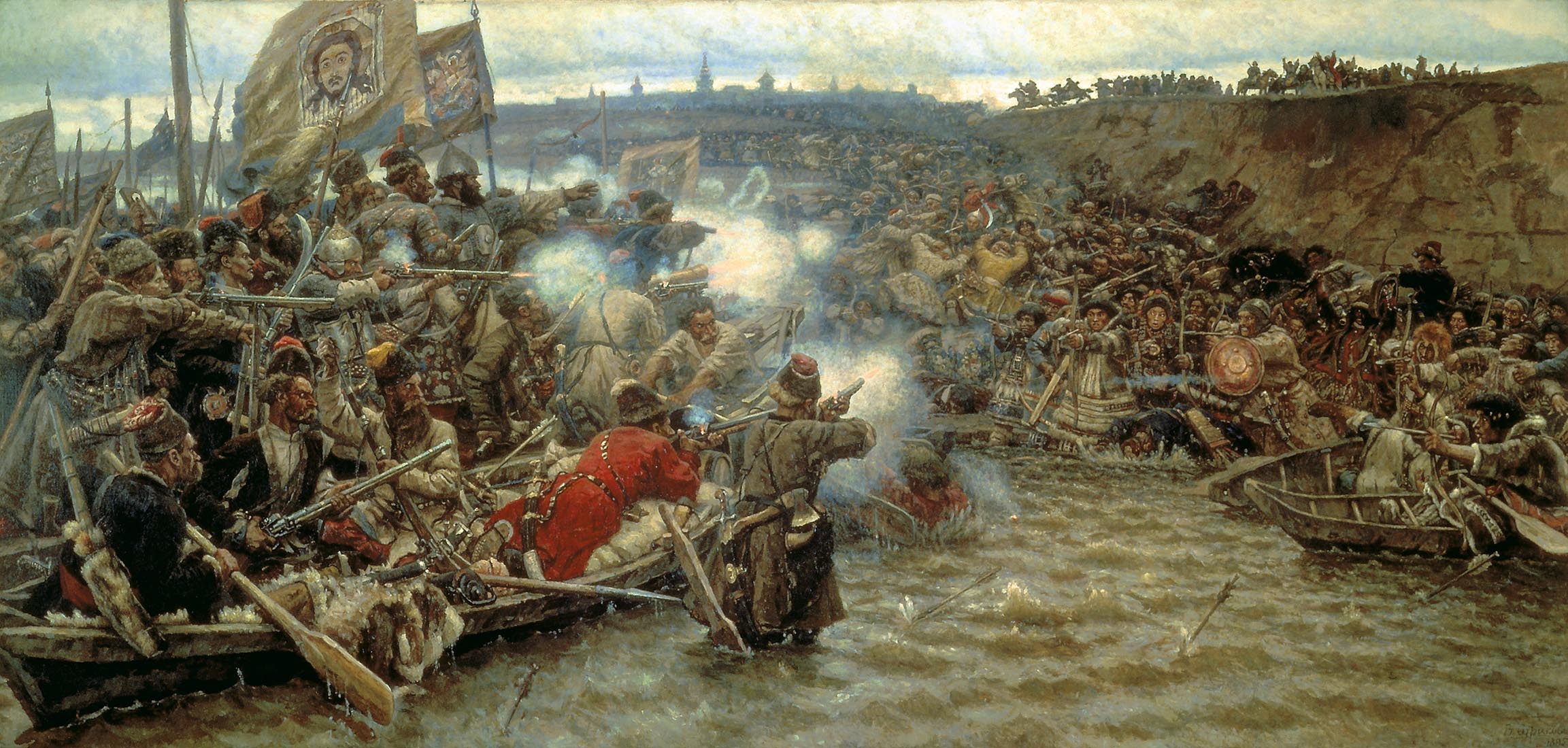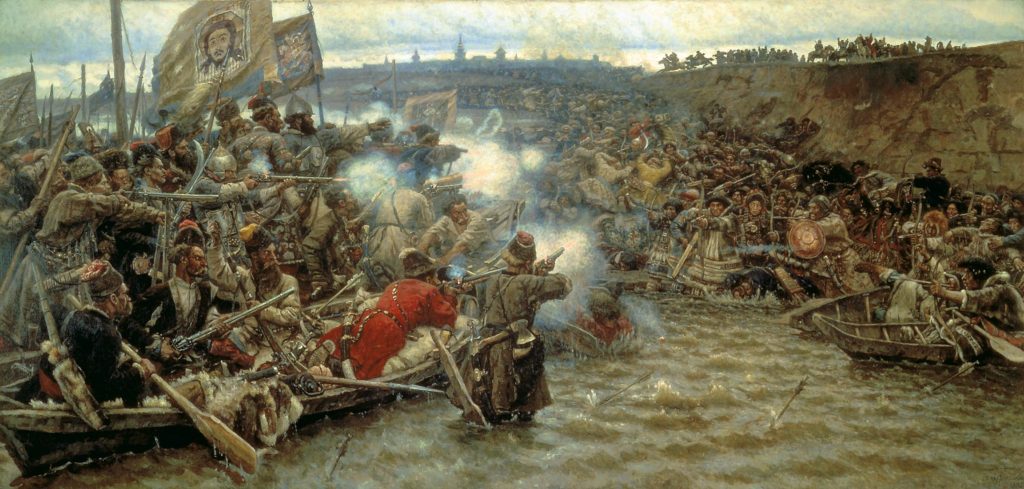The Mongols had a new neighbor in the north. In 1558 Tsar Ivan IV [Ivan the Terrible] gave land west of the Ural region, including the Kama River basin, to a merchant by the name of Grigorii Stroganov. Setting his lands with very kind of trader and peasant, Stroganov gradually expended both his territory and control eastward. By 1754 the Stroganov owned the lands east of the Ural Mountains all the way to the Tobol River and had begun mining the region for silver and iron ore.
Siberia Becomes Siberia
This marked the beginning of the cossacks, the people of the border regions. The Russian word kazak is taken from Turkish meaning an adventurer. As Lithuania, the Ukraine and Belarus had fallen into the lands of the Poles, the formerly free peasants of those lands were turned into serfs. Many fled serfdom and set up their communal settlements in the steppes of Ukraine as the first Cossacks. Russian tsars initially used this large force to protect their frontiers, and then turned the Cossacks into a major tool of their imperial expansionist policy.
A Cossacks company led by ataman Ermak Timofeyevich arrived in the Stroganov territory. Ermak, a robber and a fugitive, turned over lands he captured to the Tsar, for which he was pardoned and granted the rank of ataman (elder of a Cossack company). In 1579 Ermak set his 840-man company against the Tatar Khanate outside Russia’s eastern border. After several years of war Ermak captured the Tatar Khan Kuchiim and pushed the Russian border to the Irtysh River. The vast territory east of the Ural Mountains came to be called by the name of the Tatar capital Sibir, while Tobolsk, not far from that Tatar city, became the administrative center of the new Russian possession.
The Origin of the Buriads
At this time the territory around Lake Baikal was the land of Mongol clans and tribes of the Hori, Turned, Bargad, Tavnan, Songool and Bulgad, a people who would much later be known as the Buriad. Part of the Urianhai tumen in the times of Dayan Khan’s 300 tumen, these tribes were under the jurisdiction of the Zasagt Khan and Tusheet Khan. Today all of them are known as the Buriad.
The distinction of Buriad is more politico-geographical than ethnological. One of the Mongol clans who first encountered Russians was called Buriad. As the word sounded close to the Russian brat (brother), those Mongols who willingly recognized the sovereignity of the Russian Tsar came to be called “Buriad, and “brat.” The different Mongol tribes and clans that joined Russia mixed and melded until they formed an integral community which imparted a cultural and ethnic connotation to the word “Buriad”.
Russia Makes Its Way To The Pacific
In the early seventeenth century the Cossacks undertook three unsuccessful invasions of Khiva. So they decided to move east, into the inhospitable land of the thick taiga forests. Soon Cossacks were founding, Russian military outposts (ostrog) in the land of the Nenets, Khanty and Ket. By 1619 the Mangazeya ostrog had settled on the Taz River (present-day Obi) and the Yenisei ostrog on the Yenisei. From there the Cossacks marched on into the Evank and Tungus territories up to the line where in 1628 they came face to face with the Mongols.
Sotnik Pyotr Bekenov, the chief of a Cossacks century, moved into Yakutiya and set up the Lenskii ostrog on the River Lena where he had the first encounter with Mongols, who prevented his southward expansion. Discovering the River Amun in 1636, Beketov reached the Sea of Okhotsk in 1639, and so Russia made its way east to the Pacific Ocean.
The Russians Face the Mongols
In 1644, Kurbat Ivanov fought with Buriad clas in the area of present-day Bratsk. In the same year ataman Vasilii Kolesnikov was murdering and plundering his way along the Angara. The following year he reached Lake Baikal. The beauty of this land stirred the Russians to great activity. They set about mastering the territory by building forts and military settlements: in Verkhneangarsk in 1646, Barguzin in 1648, Selenginsk in 1665, and Verkhneudinsk in 1666.
Many poverty- stricken Russian peasants began settling down in these places and soon were turning the pastures into crop-lands, harassing the indegenous nomadic population in the process. As a result, in 1658 local Mongol tribes staged their first armed rebellion and, defeated by the Cossacks, fled to Mongolia.
The Halh-Russian Relationship Worsens
Being too few and disunited, Buriads could only engage in one-on-one fighting rather than put up a large-scale resistance. Mongols, for their part, were so engrossed in the Halh-Oirad controversies and struggles with the Manchu that they barely noticed that they were being robbed of their lands in the north. Finally in 1688-89 Tusheet Khan Chihundoij’s tribe campaigned towards Selenginsk and Ude. The objective of this campaign was to regain former Mongol lands, while the pretext for launching it was offered by the bloody Cossack reprisals that followed the Buriad revolt. Although prior to Chihundoij Mongols had five skirmishes with the Russians, this last one resulted in the radical deterioration of the relations between the Halh and Russia. Russia then began seeking direct contact with Qing China and the Dzunagr Khanate.
Chronology
- 1581: Ermak attacked Siberia.
- 1582: After defeating Kuchum’s army. Ermak invaded the Siberian capital of isker.
- 1587: The Siberian capital Tobolsk was established.
- 1604: The Russians met the Turkic tribes serving Altan Khan near Tom River.
- 1628: Krasnoyarsk fort established in Siberia.
- 1654: Some of the Mongolian Buriads joined Russia.
- 1666: Russian military fort was built in Buriad Ude.
- 1685: Tusheet Khan Chihundorj surrounded the Russian’s military forts near the Selenge, Jid and Tsoh Rivers and forced them to leave the territories of Mongolia.
- 1689: The Qing Dynasty and Russia signed their first treaty, which would be known as the Treaty of Nerchinsk.
- 1698: The Russian military fort in Ude became a city and was named Deed-Ude.
- 1727: Russia and the Qing Dynasty sign the Treaty of Hiagt and established the Halh-Russian border. By establishing the Mongolian-Russian border a small town was built which later became the foundations of the town of Hiagt. Hiagt became the commercial and economic center of Mongolia, Russia, and China.


